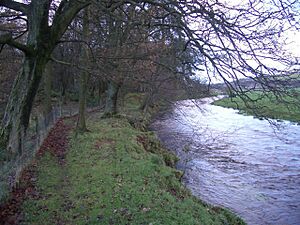Crook of Devon facts for kids
Quick facts for kids Crook of Devon |
|
|---|---|
 The Inn, Crook of Devon |
|
| Population | 760 (2020) |
| Council area | |
| Country | Scotland |
| Sovereign state | United Kingdom |
| Police | Tayside |
| Fire | Tayside |
| Ambulance | Scottish |
| EU Parliament | Scotland |
Crook of Devon is a small village in Kinross-shire, Scotland. It is about 6 kilometers (4 miles) west of Kinross. The village gets its name from the River Devon. The river makes a big, almost 180-degree turn here. This turn looks a bit like a shepherd's crook, which is a curved stick.
Contents
Discovering Crook of Devon's Past
Crook of Devon was once a very important place. It sat on a main route between Stirling and St Andrews in medieval times. The River Devon was often shallow enough to cross here. A major north-south road also met at this spot.
How the Village Grew
Because of these crossroads and the easy river crossing, people started to settle here early on. In 1615, King James VI made it a "Burgh of Barony." This meant it had special rights for trade and local government. The old market area was shaped like a triangle. You can still see this shape in the roads today.
However, new bridges were built later, moving the main roads away from the market. This stopped the village from becoming a big trading center. So, the village slowly moved south. Most of the buildings you see today were built in the 1800s.
The Famous Witch Trials of 1662
Crook of Devon is known for its witch trials in the 1600s. In 1662, 13 people were accused of witchcraft here. These trials happened between April and October of that year.
The people accused were:
- Agnes Murie
- Bessie Henderson
- Isabel Rutherford
- Robert Wilson
- Bessie Neil
- Margaret Lister
- Janet Paton the elder
- Janet Paton the younger
- Agnes Brugh
- Margaret Hoggin
- Janet Brugh
- Christian Garvie
- Agnes Pittendreich
Most of those accused, 11 out of 13, were found guilty. They confessed to practicing spells and talking with the devil. This was based on the beliefs of the time.
Remembering the Accused
Almost all of the convicted people were sentenced to death. This happened in a field called Lamblaires in the village. Two people were not sentenced to death. Margaret Hoggin passed away before her sentencing. Agnes Pittendreich was pregnant, so she was spared.
In 2012, a special "Witches' Maze" was opened at Tullibole Castle. It was created to remember the people accused of witchcraft in the area.
Changes Over Time
In 1789, the family who owned much of the land, the Hallidays, faced money problems. They sold off large parts of their estate. The old market area was bought by the Moodie family. They even took apart the old market cross, which was a stone monument.
Later, in the 1830s, the Moubray family bought the Naemoor Estate. They were involved in the coal business. They continued to help the village grow in the 1800s. The estate was eventually sold off in 1946. Today, most of the houses are owned by individuals. New houses have been built since the 1960s, with a big new development in the 1990s.
Fossoway Church: A Place of History
A church has been in Crook of Devon for a very long time. The current church building dates back to 1729. It was updated in 1806. This church replaced two older parish churches from nearby areas. These two parishes joined together in 1614. The Elizabeth Wilkie Hall was added to the church in the year 2000.
Past Leaders of the Church
Many ministers served the church for a long time. Laurence Mercer (the elder) served from 1607 to 1652. His son, Laurence Mercer (the younger), later helped him. Other notable ministers include Rev Andrew Ure (1717-1742) and Rev John Storer (1743-1778). William Graham served from 1778 to 1803, and his son George Graham served until 1824. Rev Peter Brydie served from 1824 until the Disruption of 1843. Rev William Ferguson served from 1854 to 1892. Patrick Baeda Thom, who was also a writer, took over from him in 1889. William Wilson Boyle became minister in 1918.
People Who Made a Mark
- James Haig Ferguson FRSE (1862–1934) was a surgeon. He was born in the manse (minister's house) in Fossoway.
- John Luke owned several paper mills with his sons.
- William Luke, John Luke's son, moved to Maryland in the United States. He helped create the modern way to make paper from wood pulp. The town of Luke in Maryland is named after him.
See also
 In Spanish: Crook of Devon para niños
In Spanish: Crook of Devon para niños


